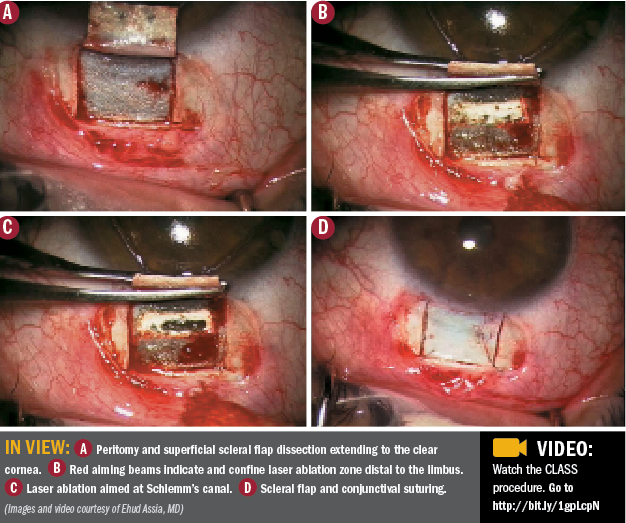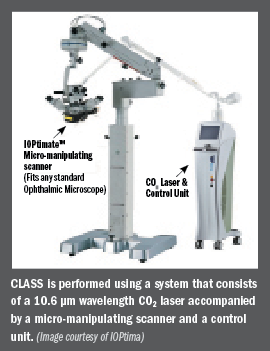Article
CO2 laser surgery a new option for glaucoma
CO2 laser-assisted sclerectomy surgery reduces elevated IOP by thinning the sclera of the eye while leaving an intact membrane.
Take home
CO2 laser-assisted sclerectomy surgery reduces elevated IOP by thinning the sclera of the eye while leaving an intact membrane.
By Shlomo Melamed, MD, Special to Ophthalmology Times

Tel Aviv, Israel-Carbon dioxide (CO2) lasers-well known for their high power and efficiency-are used in a variety of applications ranging from industrial welding to military range finding. Their most common medical application has been in the field of skin resurfacing, where they have revolutionized the field by largely replacing chemical peels.
Now, CO2 lasers are creating waves in glaucoma treatment with the new, clinically proven CO2 laser-assisted sclerectomy surgery (CLASS, IOPtima).
Glaucoma is most frequently treated with hypotensive topical medications that have proven to be effective at lowering IOP when used according to their prescribed regimen.1
However, patient compliance remains a significantly limiting factor.2 The drops can be expensive, difficult to insert correctly, and negatively impact quality of life with myriad side effects.
Traditional penetrating glaucoma surgery has enough drawbacks that a whole field of micro-invasive surgeries has cropped up to provide alternatives for patients with mild to moderate glaucoma. CLASS, a procedure that reduces elevated IOP by thinning the sclera of the eye while leaving an intact membrane, is an alternative to many of these devices. Fluid is able to percolate through the sclera of the eye, and aqueous flow is successfully regenerated without penetrating the eye globe. In addition, there is no need to insert and leave a foreign body in the eye.

Performing the procedure
CLASS is performed using a system (IOPtimate, IOPtima) that consists of a 10.6 µm wavelength CO2 laser accompanied by a micro-manipulating scanner and a control unit.
The surgeon first performs a peritomy and superficial scleral flap dissection, which extends to the clear cornea. The zone directly above Schlemm’s canal is then ablated with the laser, removing scleral tissue layer by layer until fluid begins to percolate. Once sufficient aqueous humor percolation is achieved through the thin membrane, the scleral flap is replaced and sutured, as is the conjunctiva.
The micro-manipulating scanner on the system uses an aligned laser-aiming beam, which identifies and confines the laser ablation zone located proximately to the limbus. As CO2 laser is nearly completely absorbed by liquid, as soon as the aqueous begins to percolate through the sclera the ablation effect is automatically halted.
Clinical perspective
A prospective, multicenter study of 111 patients underwent CLASS. Eighty-five eyes had primary open-angle glaucoma (POAG) and 26 were diagnosed with pseudoexfoliative glaucoma (PEXG)-all with an average IOP of 25.7 + 5.3 mm Hg.

Six months postoperatively, mean IOP dropped to 13.5 + 3.7 mm Hg (n = 86) and has remained stable through 3 years (n = 29). This represents an IOP reduction of 20% or greater in more than 87% of patients, with 59.4% of patients able to maintain their IOP goals without the use of any medication. The mean number of glaucoma medications dropped from 2.3 +1.2 medications at baseline to 0.6 + 0.8 medications after 3 years.
CLASS is an appropriate treatment option for POAG and PEXG patients with baseline IOP between 20 and 35 mm Hg, and possibly even higher.
The learning curve for the surgeon is relatively short. The most important skills for the surgeon to master are how to create the appropriate scleral flap and become comfortable manipulating the laser. The laser is precisely guided by the micro-manipulating beam, and will ablate exactly the shape and dimensions defined. Surgeons simply have to exercise confidence in the device. Intraoperative and postoperative risks are significantly reduced by not penetrating the globe.
Benefits of procedure
One of the greatest benefits of CLASS is the ease of performing the procedure. The technique for unroofing the canal is very safe yet productive. IOP is significantly reduced without the risk of hypotony and impact on vision is minimal, if at all
I continue to use a variety of glaucoma procedures, but find that CLASS may be most suitable for patients with uncontrolled glaucoma where a less-invasive approach is preferred. A head-to-head study comparing CLASS with trabeculectomy will provide an answer on whether the laser-assisted approach can replace trabeculectomy.
With more than 700 procedures performed to date worldwide, CLASS is a very promising technology. It works well-providing significant, long-term reductions in both IOP and hypotensive medication requirements. It also has a very low postoperative complication rate. Future studies will continue to show the benefits of using CO2 lasers for the treatment of glaucoma.
Shlomo Melamed, MD, is full professor of ophthalmology, incumbent of the Zuker-Sussman Chair for Glaucoma Research, Tel Aviv University Medival School, and director of the Sam Rothberg Glaucoma Center, Tel Hashomer, Israel. Dr. Melamed receives consultation fees or grants from Allergan, Ellex, IOPtima, and SOLX.
Newsletter
Don’t miss out—get Ophthalmology Times updates on the latest clinical advancements and expert interviews, straight to your inbox.




